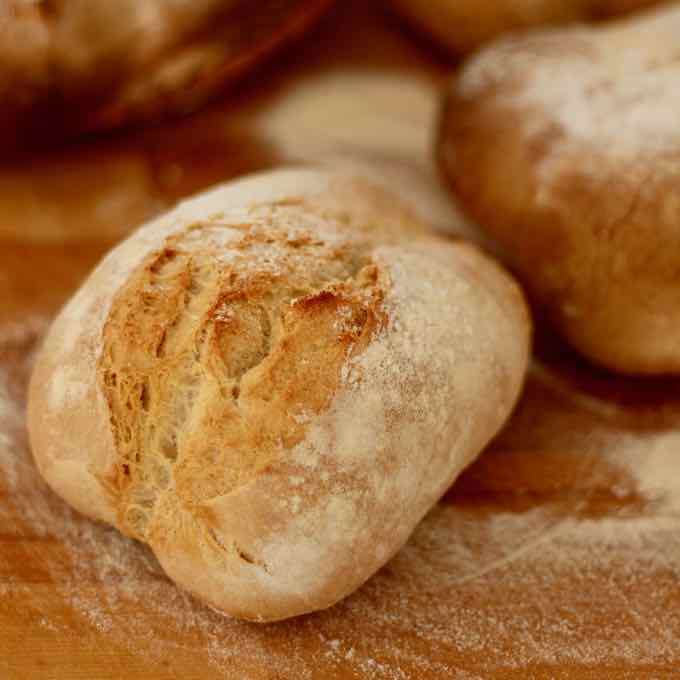
5.0 from 3 votes
Pão Alentejano
Pão alentejano, the Portuguese name for Alentejo bread, is a delicious, long-fermented bread made with natural yeast starter. It has a slightly acidic aftertaste, a compact crumb and a thick rustic crust.
Prep Time
2 hrs
Cook Time
mins
Resting Time
5 d
Total Time
2 hrs 40 mins
Servings: 3 loaves
Course:
Bread
Cuisine:
Portuguese , Vegan
Ingredients
For the leaven
- Organic rye flour
- lukewarm water
- ¼ teaspoon honey
For the bread
- 8 cups bread flour
- 2¼ cups warm water at 80 F (or more water if necessary)
- 10 oz. starter (prepared the day before)
- 3 teaspoons salt
Equipment
- Spatula
- glass jar (sterilized)
- Electronic scale
- Stand mixer
Instructions
Leaven
Step 1
- Heat 1 oz (25ml) of water. The temperature must be around 80F/25C.
- In a glass jar, add 1 oz (25g) of flour and 1 oz (25ml) of lukewarm water.
- Add the honey.
- Stir vigorously until a thick porridge texture is obtained.
- Place the lid on the jar, leaving it ajar so that air can enter.
- Place the jar in a warm, draft-free place for 12 hours.
Cup of Yum
Step 2
- At the end of these 12 hours, feed the leaven by adding 1 oz (25ml) of warm water and 1 oz (25g) of flour.
- Mix well and place the yeast back in a warm place, protected from drafts.
Step 3
- On the following days, feed the leaven every 12 hours.
- To do this, remove half the yeast, or 2 oz (50g) before feeding it by adding water and flour.
- For each refresh (feeding), add 1 oz (25ml) of warm water and 1 oz (25g) of flour.
- Mix well and plate the leaven in a warm protected area.
- After 3 or 4 days, very small bubbles will form on the sides of the jar. If so, the leaven is born! Otherwise, wait another 1 or 2 days.
- At this stage the leaven must have a slightly sour odor, which is normal.
Step 4
- When the starter is born, you must continue to feed (refresh) it to energize it: every 24 hours for at least 3 days, until the leaven has tripled in volume.
- Do not forget to remove half of the leaven before feeding it.
Step 5
- The mother dough is ready.
- In a large salad bowl, put 5 oz (150g) of mother dough.
- Add 2½ oz (75g) of flour and 2½ oz (75ml) of lukewarm water. Mix well and let rise in a warm, draft-free place for 8 hours.
Pão Alentejano
- In the bowl of a stand-mixer with the dough hook attachment, add the flour and 2¼ cups (600ml) of water.
- Knead for 3 minutes at very low speed. A ball must form.
- Cover the bowl and let the dough rest for 30 minutes. This step is called autolysis. It allows a biological modification of the flour that will later give a more elastic dough, that is easier to work. This also plays on the final appearance of the crust.
- After 30 minutes, add the leaven and salt to the bowl and start kneading.
- Knead for 1 minute at the lowest speed.
- Then, turn on speed 2 until the dough gains in elasticity to become firmer and smoother.
Test the dough
- Form the bread into balls. It must relax a little but still keep its shape. If it is too soft, add a little flour. On the contrary, if the dough is too firm, gradually add a few tablespoons of lukewarm water.
- Grease a large salad bowl with oil and put the dough in it.
- Cover with a cloth and let it rise at room temperature for 1h30, away from drafts.
- After 1h30, dust the work surface with flour.
- Use a spatula to get the dough and put it on the work surface without "damaging" it.
Folding (to give more body to the dough)
- Form a square and fold the dough by folding the sides towards the center.
- Turn the dough, bend underneath, shape quickly into a ball and put it back in the bowl.
- Cover it with a cloth and let it rise in the refrigerator for 8 hours.
- At the end of these 8 hours, proceed again to the folding stage.
- Place the dough in the bowl, cover with a cloth and let the dough rise again for 3 hours at room temperature, if possible near a heat source, away from drafts. It must double in size.
- Place the dough back on the work surface, always with a silicone spatula to avoid any tearing.
- Roughly form 2 or 3 pieces of equal weight, into a ball. Cover them with a cloth and let them relax for 15 minutes.
- Form the loaves. To help you, here is a video for the different forms of pão alentejano https://youtu.be/rYYQC6VLrt8.
- Place the dough on a baking sheet lined with parchment paper, making sure to leave enough space between them.
- Let the formed loaves rest again for 2 hours away from drafts.
- Place a baking sheet at the bottom of the oven and fill it with water.
- Preheat the oven to 450F/230C.
- Place the baking sheet with the loaves in the center of the oven that should already be filled with steam.
- Bake for 10 minutes, then reduce the heat, and bake for 30 minutes at 410F/210C.
- The bread is baked when the crust is rather dark.
Notes
- What to do with the leaven that is removed from the jar before each feeding? It can be used in pancake or cake dough, buns, blinis, or pizza dough for example.